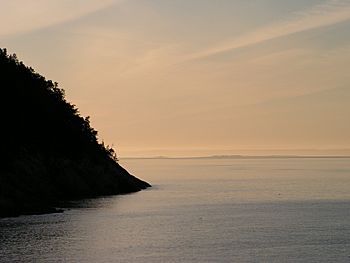Estuary of Saint Lawrence facts for kids
Quick facts for kids Saint Lawrence Estuary |
|
|---|---|

Estuary of Saint-Laurent at Port-au-Saumon (Quebec).
|
|
| Other name(s) | Estuaire du Saint-Laurent (in French) |
| Country | Canada |
| Province | Quebec |
| Physical characteristics | |
| Main source | Saint Lawrence River Lake Saint-Pierre, Trois-Rivières, Quebec, Canada 46°16′17″N 72°38′5″W / 46.27139°N 72.63472°W |
| River mouth | Gulf of St. Lawrence / Atlantic Ocean Pointe-des-Monts, Quebec, Canada 0 m (0 ft) 49°08′N 67°14′W / 49.133°N 67.233°W |
The estuary of the Saint Lawrence in Quebec, Canada, is one of the largest estuaries in the world. An estuary is a special place where a river meets the sea. Here, fresh water from the river mixes with salty ocean water. This creates a unique environment that is home to many different kinds of plants and animals.
Contents
Where is the Saint Lawrence Estuary?
The estuary of the St. Lawrence River is located just after the river itself. It is also found before the wider Gulf of St. Lawrence. This is the exact spot where the fresh river water and the salty ocean water meet and mix.
The St. Lawrence Estuary starts at Lake Saint-Pierre. It stretches all the way to where the shores widen near Pointe-des-Monts, Quebec. This point is across from Les Méchins, Quebec.
Sections of the Estuary
The St. Lawrence Estuary is divided into three main parts:
- The River Estuary: This part is near Île d'Orléans (Orleans Island).
- The Middle Estuary: This section extends to the Saguenay Fjord.
- The Maritime Estuary: This is the final part, reaching all the way to Pointe-des-Monts, Quebec.
Mixing Waters and Turbidity
A key feature of the St. Lawrence Estuary is its "saline front." This is where the salt water begins to appear. It's located at the eastern tip of Île d'Orléans.
Where fresh and salt water meet, there's a lot of suspended matter. This means tiny bits of dirt and other particles are floating in the water. This creates a "zone of maximum turbidity" (MTZ). Turbidity means the water is cloudy or murky. This cloudy zone can be from 70 to 120 kilometres (43 to 75 mi) long. Its length changes depending on how much water the river is flowing.
This murky zone is found between Île d'Orléans and Île aux Coudres. Even though it's cloudy, this area is very important for life. The way the water moves and mixes here makes it a great place for tiny plants and animals to grow. It also serves as a safe nursery for many young fish. The cloudy water helps hide the young fish from predators. It also keeps the water at the right temperature and saltiness for them to grow. The changing saltiness and cloudiness create many different conditions. This supports a wide variety of tiny water creatures and communities.
Animals and Plants
The Saint Lawrence Estuary is a vibrant home for many species. A very special animal found here is the beluga whale. These white whales are an important symbol of the estuary.
Many other types of fish and sea creatures also live in these waters. Scientists and local people are working together to count the fish in the estuary. They are creating a guide to help identify all the different fish species. This is a great example of citizen science, where everyone can help with scientific research.
See also
 In Spanish: Estuario del San Lorenzo para niños
In Spanish: Estuario del San Lorenzo para niños



